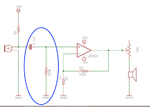preethi19
Full Member level 5
Using high pass filter infront of an opamp
Hi i have attached an image of an op-amp circuit amplifying the signal from the microphone.

The link is https://www.youtube.com/watch?v=TQB1VlLBgJE
My question is in the video it is told that the microphone inputs 20mV signal and it is powered by the 9V supply. So what happens is der occurs a DC offset with the 20mV input signal shifting from 0 to 9V. So in order to remove this DC component they have used a high pass filter.. My question is
why use a high pass filter to block the DC component. A capacitor also blocks DC. So why not just use a capacitor in the path of the input signal to the opamp input to remove the 9V DC.
Hi i have attached an image of an op-amp circuit amplifying the signal from the microphone.

The link is https://www.youtube.com/watch?v=TQB1VlLBgJE
My question is in the video it is told that the microphone inputs 20mV signal and it is powered by the 9V supply. So what happens is der occurs a DC offset with the 20mV input signal shifting from 0 to 9V. So in order to remove this DC component they have used a high pass filter.. My question is
why use a high pass filter to block the DC component. A capacitor also blocks DC. So why not just use a capacitor in the path of the input signal to the opamp input to remove the 9V DC.